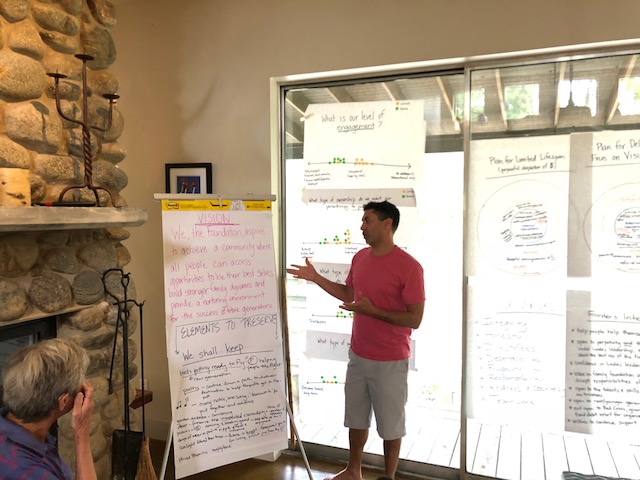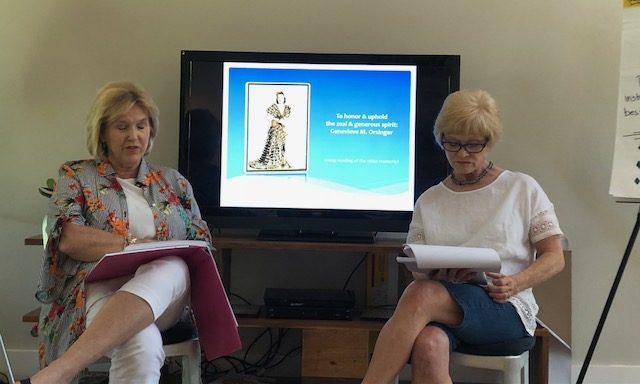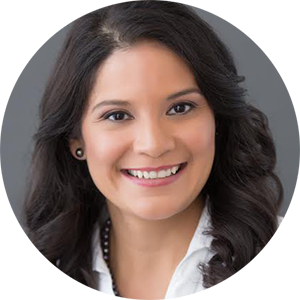
The Stanzel Family Foundation, Inc.
July 8, 2020CIVICAIM CASE STUDY
Giving While Living: Strategically Spending Down a Foundation for More Impact
Challenge
In 2018, the Genevieve & Ward Orsinger Foundation grappled with how to develop a vision for the over two decade old Foundation’s future, one that incorporated the late founder’s intent and interests, and to articulate the strategic goals and activities that would support the vision going forward.Approach
Erica Ekwurzel of CivicAIM designed and facilitated a strategic planning retreat that asked participants to consider: What is our purpose? Where are we going? Which giving model is best equipped to advance our vision? In a three-day strategic planning retreat, the board discussed the pros and cons of different giving vehicles, and how each aligned to their vision, values, philanthropic style, and honoring the founder’s intent.Outcomes
With CivicAIM’s facilitation and counsel, the Foundation crafted a clear vision statement for the Foundation’s future, and in a pivotal decision, agreed to a limited lifespan approach using a spend-down model that would close the Foundation within 5 to 10 years. Today, the Foundation is implementing this spend-down plan, concentrating its giving on one grantmaking initiative as opposed to many, and making larger grants for more immediate impact.Designing a Strategic Planning Retreat for Results
In 2018, the Genevieve & Ward Orsinger Foundation grappled with how to develop a vision for the 20+ year Foundation’s future, one that incorporated the late founder’s intent and interests, and to articulate the strategic goals and activities that would support the vision going forward. Foundation board and staff held different philosophies about how to lead into the future—and who would do it. The long-time president planned to eventually retire from the role, and there was no next-gen family leader available to assume the position.
The board needed a skilled outside expert to facilitate board discussion and guide them in thoughtful reflection and strategic planning—with decisions that would affect both the future of the Foundation and its grantee partners and larger community.

Erica offered us a more organized approach, an openness to ideas, and a neutrality that we would not have otherwise had. Her questions helped us think outside of the box, and we were able to come up with ideas that made us better because of it.
– Linda McDavitt, President/CEO
“This retreat was a critical juncture for the Foundation, as we needed to make decisions about succession and how the Foundation could have its greatest impact,” said Linda McDavitt, lifetime president and the founder’s niece. “Continuing to uphold our founder’s intent was a key consideration for us in developing our vision.” As the founder’s closest living family member, Linda has been leading the Foundation since Genevieve McDavitt Orsinger passed away in 2004.
The Foundation engaged Erica Ekwurzel of CivicAIM to design and facilitate a strategic planning retreat that asked participants to consider: What is our purpose? Where are we going? Which giving model is best equipped to advance our vision?
Prior to the retreat, Erica interviewed trustees and staff and presented key findings from those interviews, exploring topics including the connection to the Orsinger family, the trustees’ role, grantmaking initiative and impact, and ideas for the future.
“One-on-one interviews, conducted before a retreat by a neutral, unbiased outside philanthropic advisor, is key in uncovering assumptions and giving board members the opportunity to share their unfiltered views,” said Erica. “What these interviews reveal raises the most interesting discussion points at the meeting, and moves the board’s decision making forward.”
Over the course of the three-day retreat (Friday evening, Saturday day, and Sunday half-day), Erica kept the board focused on the purpose, asking the group to reflect on historic highlights and current efforts that shaped the Foundation as it is today. Participants reflected on the life, personality, and spirit of the philanthropy’s founder, and explored their own motivations and aspirations for the Foundation. When prompted on their ideas on the Foundation’s future, a majority of trustees affirmed that they hoped to continue the good work of creating social good, in alignment with the founder’s values.
Articulating a Shared Vision and Philanthropic Style
During the retreat, Erica led trustees through a “We, the Foundation, aspire to achieve” activity that provided a pathway for the board to create a shared vision statement:
We, the Genevieve & Ward Orsinger Foundation, aspire to achieve a community where all people can access opportunities to be their best selves, build stronger family dynamics, and provide a nurturing environment for the success of future generations.
With the new vision in hand, Erica facilitated group discussion to self-evaluate the Foundation’s philanthropic style and approach—how the Foundation practices its work and makes decisions on community investments. The board considered the following questions:
- What is our level of engagement as a Foundation?
- What type of ownership do we want our philanthropy to project?
- What type of community player do we want to be?
- What type of impact do we seek?


These questions led to a focused discussion on perpetuity. The group discussed the pros and cons of different giving vehicles, and how each aligned to their vision statement, values, founder’s intent, and philanthropic style. They discussed three potential scenarios for the future: 1) drive the vision forward for five years, with an openness to perpetuity, 2) plan for a limited life span (spending down the Foundation’s assets), or 3) transition to a Donor Advised Fund (DAF) or bank trust. For each of these scenarios, trustees considered the implications on internal operations, grantees, and the larger community.
“This scenario planning activity helped participants “try on for size” each approach and vehicle to explore how it could best advance their vision,” said Erica. “I purposefully structured this activity and retreat so that no embedded assumptions would sway the board’s thinking, and they could actively and collectively create the Foundation’s future,” said Erica.
Reflection Walk
According to Linda McDavitt, one of the most thoughtful moments of the retreat was when participants went on a “We Shall Keep … Reflection Walk.” This facilitated break gave participants a chance to individually reflect on the different possibilities for the Foundation’s future. Erica asked the group to spend some quiet time walking outside, and to choose a prop or object that symbolized how they hoped to sustain and strengthen the Foundation’s legacy. When trustees returned from their walks, they shared many images and ideas evoked what preserving the Foundation meant to them. This included birds getting ready to fly (symbolic of the Foundation’s focus on helping people take flight); a garden gazebo (symbolic of the Foundation’s role as a convener); a deer (welcoming a sense of wonder and the unexpected); and drops of water in a pool (a reminder of the ripple effect and influence that the Foundation has had on the community).
The Spend-Down Decision: Making a Larger Impact While Living
At the retreat, Linda McDavitt emphasized that “It’s important to see a larger impact in our lifetimes.” She proposed a spend-out approach, with a three- to five-year strategic plan to help guide and evaluate the Foundation’s work and community investments. This plan would give the Foundation a roadmap for spending the Foundation’s assets within 5-10 years, with flexibility for the board to accelerate or slow payments, depending on external factors such as financial markets, grantee need, or desired impact. The board agreed in consensus.
The retreat model emphasized the teamwork—a core organizational value—where all trustees were actively involved in the design and implementation of the Foundation’s grantmaking strategy. This was a big change for the Foundation, as most of the decisions in the past had been led by Linda or the Foundation’s founder, Genevieve.
A spend-down (also called a spend-out, sunset, limited life, or wind-down) means a foundation intends to give away all of its philanthropic resources within a specific, limited timeframe and then close their doors.
Foundations do this for a variety of reasons. Commonly, a specific event happens that inspires the spend-down decision: Perhaps a business is sold, or a founder passes away. Or board members realize they will age out and/or lose interest, and they don’t have a reasonable or satisfying succession plan in place. Other times, the family and/or board members decide they want to “give while they live” and personally see the impact that leveraging all of their philanthropic resources can make on the urgent issues of today’s world.
For the Genevieve & Ward Orsinger Foundation, this spend-down model has had direct implications to internal operations, existing and future grantee partners, and the larger philanthropic communities that the Foundation serves. It has also brought more focus to what the Foundation funds. Today, the Foundation is thoughtfully implementing this spend-down plan, concentrating its giving into one initiative as opposed to many, and making larger grants for more immediate impact. The spend-down model also gave the Foundation latitude to positioned itself easily and readily to provide emergency funding for issues related to the COVID 19 pandemic and 2021 freeze across Texas.
“We wanted to honor Genevieve’s vision of helping those who wanted to help themselves move forward and have a better life as individuals and for their family. We were tired of giving small five or ten thousand-dollar grants like Band-aids. They weren’t going anywhere,” said Linda. “Because of the spend down, we’ve have focused our grantmaking and given bigger grants. We’ve been able to continue Genevieve’s focus areas in a more direct and strategic manner and have been able to see better results.”
Grant funding now goes to support the Strengthening the Family Unit initiative, which is based on a “Dual-Gen” (two generation) philosophy that evolved out of the 2018 retreat. “While many programs tend to arrange parent-oriented and child-oriented programs into separate silos, Dual Gen programs and policies seek to engage families in ways that knit together these services and address both groups simultaneously,” said Linda. 2022 will be the fourth year of the initiative.
“Our funding focus represents our commitment to improve the quality of life for families in our designated counties, and to be the most effective partners and a catalyst for the nonprofit community,” said Linda. “I believe Genevieve would have been proud of the decision to focus on impact and make a difference now in the lives of the communities we serve.”
Lessons Learned in Spending Down
Linda McDavitt and others shared these points of advice for foundations considering a spend down.
1. Get clear on: what is it you are trying to accomplish with the philanthropy? Is the foundation primarily to honor the founder’s legacy? Keep the family together over time? Teach the next-gen about wealth and giving? Make a true impact on the community? The board needs to be clear—and honest—about the foundation’s primary goal in order to develop a vision for the future.
2. Understand the founder’s intent and the foundation’s commitment to perpetuity. In the majority of foundations established, “in perpetuity” is added to the bylaws as a matter of default. Yet is that what the founder really intended? Is that what the current family and/or board really want? Is that the most effective way to serve the public good?
For example, at the Genevieve & Ward Orsinger Foundation, the original bylaws stated that the Foundation would exist in perpetuity. This raised some questions. “When Genevieve was still alive, we worked with a philanthropy advisor who asked us: ‘Genevieve, what happens when you’re gone? And what happens when Linda is gone?’” Our answer was simple: ‘We don’t know.’ If she hadn’t asked that question, we would have never thought about it—and the Foundation would still be in perpetuity today.”
It helps to have some flexibility in the bylaws and policies so that the foundation can evolve with the family. It also helps to revisit the “perpetuity question” every three-to-five years.
3. Talk with other foundations who have done it. For example, the Genevieve & Ward Orsinger Foundation reached out to the Pascale Sykes Foundation, which has a similar programmatic focus and is sunsetting in 2022. Learning from peers can be incredibly helpful to the spend-down planning process. Contact CivicAIM for support in finding peer foundations that have or are planning to spend down.
4. Have a goal in mind for the spend down. This is the foundation’s chance to get to the root of the social issue you want to solve. What big bets can you make? How long do you need before you will see progress? Having these conversations and doing this scenario planning will help you craft your spend-down plan. “For us, we realized that parenting skills and basic job skills were at the root of giving kids a good start. And then getting the kids into daycare or a good Early Head Start program would help them learn what they weren’t learning at home,” said Linda. “Once we paired these two together in our ‘Dual-Gen’ philosophy, we were able to achieve more impact than we had when we put them in a silo.”
5. Build in flexibility to the spend-down plan. Your plan needs to include guidance on disbursement of remaining assets. It may take the form of a full spend down, a short-term spending plan that allows time for transition, or a hybrid of the two. Whichever way you choose, be sure to put your dissolution plan in writing, and allow for flexibility. For example, the Orsinger Foundation planned to accelerate or slow payments, depending on external factors such as financial markets, grantee need, or desired impact. This has been important in adjusting to circumstances. “Our plan hasn’t worked out the way we thought it would,” said Linda. “Two full years later, we are only $2M down from where we started from—even though we’ve dispersed $4.5M. The spend-down is taking longer because of market fluctuations.”
6. Communicate clearly with grantee partners, and have an exit plan in place. The Orsinger Foundation held meetings with its grantee partners to communicate the spend-down and new initiative. “Our grantees were intrigued and caught off guard at first, not sure what it would mean to them. Many didn’t realize their $10K would turn into a $100K grant.” For the three (out of 29) grantee partners that no longer fit the new initiative’s grantmaking guidelines, the Foundation implemented an exit strategy to taper funding and introduce them to other funders.
7. Recognize that the spend-down will affect the larger community and field. Ask yourselves: what gaps will our closure have on the community or our peer groups? How can we plan in advance to ease that transition? For example, the Orsinger Foundation has led a Funder’s Group in San Antonio since 2007, and its forthcoming spend-down means that someone else must step in and take the lead. The Foundation brought this to the attention of the group early so that there is enough lead time to secure new leadership.
8. Share your learnings with the wider philanthropy field. Although this trend may be slowly shifting, the vast majority of family foundations have decided that they will exist in perpetuity. This means that those foundations that do spend down are fewer and farther between, and therefore have valuable lessons that can inform the field. Contact CivicAIM if you have or are planning to spend down, and would like to share your lessons learned.

Working with Erica and CivicAIM
With her education and historical knowledge of philanthropy, Erica is a critical thinker who brings fresh ideas to her clients. “Erica brought the neutrality that we needed, and it was key to our success. She didn’t have any prior ties to our grantees, and her thoughtful, objective approach allowed us to uncover underlying bias and recognize our own blind spots,” said Linda McDavitt. “She is easy to talk to, and asked us thoughtful questions, led us through reflection exercises, and was able to moderate skillfully, getting us to a middle ground we could agree on. We now have a clear vision for the future and a spend-down plan in place that will impact our community in a larger way during our lifetimes. We couldn’t have done it without Erica’s style and expertise—the retreat was very well done.”
About the Genevieve & Ward Orsinger Foundation
The Genevieve & Ward Orsinger Foundation in San Antonio, Texas, is dedicated to helping those who are willing to help themselves through education, cultural enrichment, and human services. Its grantmaking has focused on supporting organizations in Bexar, Comal, Guadalupe, Hays, Kendall, and Travis counties in Texas.
In 1980, Genevieve and Ward gave 15 acres of land to Bexar County to establish Orsinger Park. Following Ward’s death in 1983, Genevieve continued their vision by building and dedicating a pavilion at the park in his memory. She formally established the Foundation in 1997 to ensure that the legacy of the couple’s philanthropy would continue beyond their lifetime.
Genevieve was a gracious and charming lady who loved life and people. Her philanthropy started as a young child, when she and several of her friends performed for charity fundraisers. Prior to starting the Foundation, she gave gifts personally through a trust at the San Antonio Area Foundation. She loved helping people, inspiring people to be not only the best that they could be, but to be more than they thought they could be. According to her niece, Linda McDavitt, president and CEO of the Foundation, “She was always willing to help those who were willing to help themselves. I saw this over and over.”
Today, the board is run by seven members, both family and nonfamily. Linda has been president of the Foundation since 2004.
What’s your Philanthropic AIM?
CivicAIM is a philanthropy consulting firm that supports mission-driven families, small-staffed foundations, and grantmaking organizations, including funder collaboratives and giving circles. Together with you, we develop and execute grant and evaluation strategies that lead to the greatest impact—and we facilitate critical conversations and transitions that lead to the most meaningful and satisfying experience in your philanthropy.
Strategically Spending Down a Foundation for More Impact
